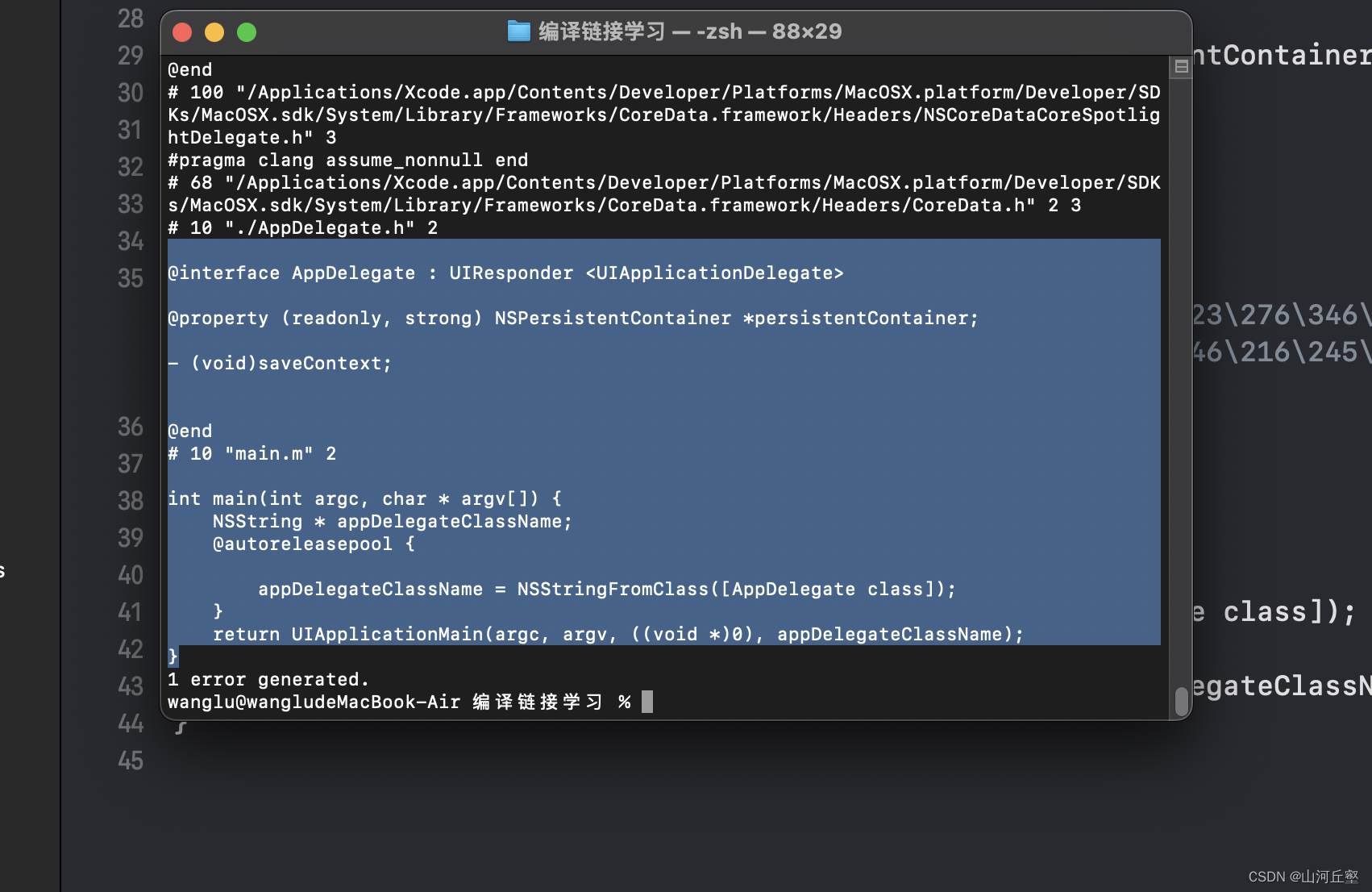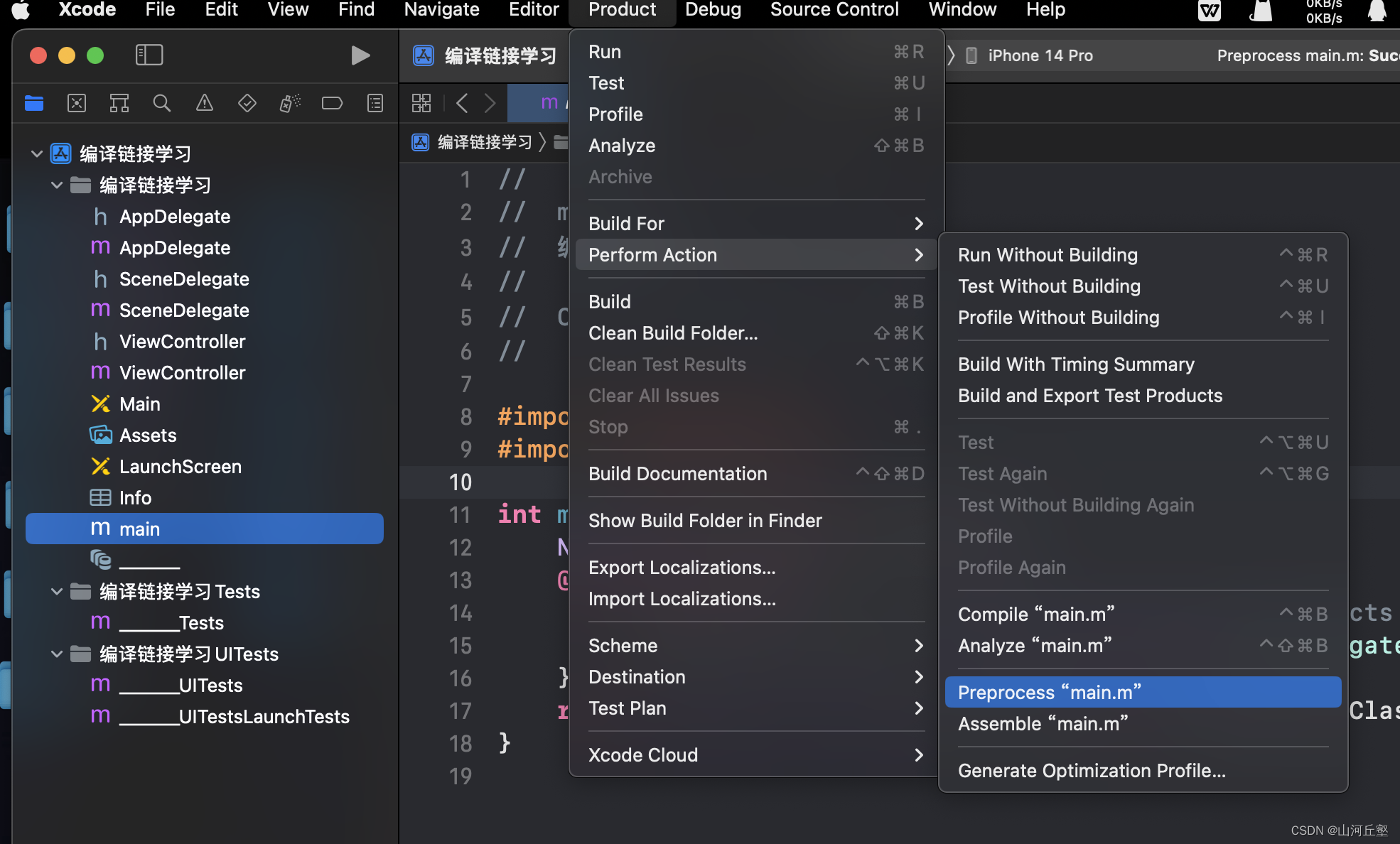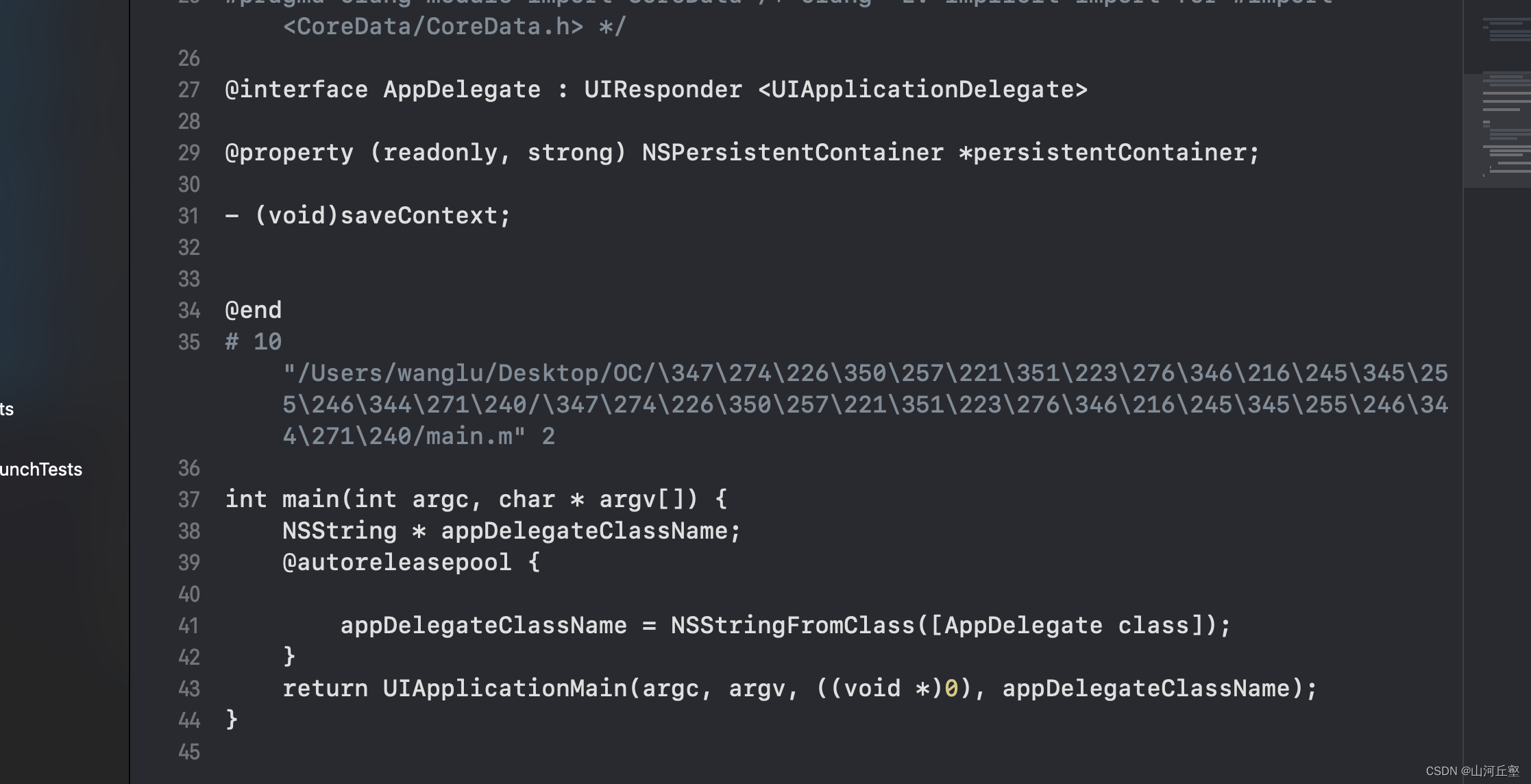前言
iOS 开发中使用的是编译语言,所谓编译语言是在执行的时候,必须先通过编译器生成机器码,机器码可以直接在CPU上执行,所以执行效率较高。他是使用 Clang / LLVM 来编译的。LLVM是一个模块化和可重用的编译器和工具链技术的集合,Clang 是 LLVM 的子项目,是 C,C++ 和 Objective-C 编译器,目的是提供惊人的快速编译。下面我们来看看编译过程,总的来说编译过程分为几个阶段: 预处理 -> 词法分析 -> 语法分析 -> 静态分析 -> 生成中间代码和优化 -> 汇编 -> 链接
具体过程
预处理
我们以一个实际例子来看看,预处理的过程,源码:
#import <UIKit/UIKit.h>
#import "AppDelegate.h"
int main(int argc, char * argv[]) {
NSString * appDelegateClassName;
@autoreleasepool {
// Setup code that might create autoreleased objects goes here.
appDelegateClassName = NSStringFromClass([AppDelegate class]);
}
return UIApplicationMain(argc, argv, nil, appDelegateClassName);
}
使用终端到main.m所在文件夹,使用命令:clang -E main.m,结果如下:
@interface AppDelegate : UIResponder <UIApplicationDelegate>
@property (readonly, strong) NSPersistentContainer *persistentContainer;
- (void)saveContext;
@end
# 10 "main.m" 2
int main(int argc, char * argv[]) {
NSString * appDelegateClassName;
@autoreleasepool {
appDelegateClassName = NSStringFromClass([AppDelegate class]);
}
return UIApplicationMain(argc, argv, ((void *)0), appDelegateClassName);
}

也可以使用Xcode的Product->Perform Action -> Preprocess得到相同的结果

这一步编译器所做的处理是:
- 宏替换
在源码中使用的宏定义会被替换为对应#define的内容)
建议大家不要在需要预处理的代码中加入内联代码逻辑。 - 头文件引入(#include,#import)
使用对应文件.h的内容替换这一行的内容,所以尽量减少头文件中的#import,使用@class替代,把#import放到.m文件中。 - 处理条件编译指令 (#if,#else,#endif)
词法解析
使用clang -Xclang -dump-tokens main.m词法分析结果如下:
int 'int' [StartOfLine] Loc=<main.m:14:1>
identifier 'main' [LeadingSpace] Loc=<main.m:14:5>
l_paren '(' Loc=<main.m:14:9>
int 'int' Loc=<main.m:14:10>
identifier 'argc' [LeadingSpace] Loc=<main.m:14:14>
comma ',' Loc=<main.m:14:18>
char 'char' [LeadingSpace] Loc=<main.m:14:20>
star '*' [LeadingSpace] Loc=<main.m:14:25>
identifier 'argv' [LeadingSpace] Loc=<main.m:14:27>
l_square '[' Loc=<main.m:14:31>
r_square ']' Loc=<main.m:14:32>
r_paren ')' Loc=<main.m:14:33>
l_brace '{' [LeadingSpace] Loc=<main.m:14:35>
at '@' [StartOfLine] [LeadingSpace] Loc=<main.m:15:5>
identifier 'autoreleasepool' Loc=<main.m:15:6>
l_brace '{' [LeadingSpace] Loc=<main.m:15:22>
identifier 'NSLog' [StartOfLine] [LeadingSpace] Loc=<main.m:17:9>
l_paren '(' Loc=<main.m:17:14>
at '@' Loc=<main.m:17:15>
string_literal '"%d"' Loc=<main.m:17:16>
comma ',' Loc=<main.m:17:20>
numeric_constant '1' Loc=<main.m:17:21 <Spelling=main.m:12:16>>
r_paren ')' Loc=<main.m:17:27>
semi ';' Loc=<main.m:17:28>
return 'return' [StartOfLine] [LeadingSpace] Loc=<main.m:19:9>
identifier 'UIApplicationMain' [LeadingSpace] Loc=<main.m:19:16>
l_paren '(' Loc=<main.m:19:33>
identifier 'argc' Loc=<main.m:19:34>
comma ',' Loc=<main.m:19:38>
identifier 'argv' [LeadingSpace] Loc=<main.m:19:40>
comma ',' Loc=<main.m:19:44>
identifier 'nil' [LeadingSpace] Loc=<main.m:19:46>
comma ',' Loc=<main.m:19:49>
identifier 'NSStringFromClass' [LeadingSpace] Loc=<main.m:19:51>
l_paren '(' Loc=<main.m:19:68>
l_square '[' Loc=<main.m:19:69>
identifier 'AppDelegate' Loc=<main.m:19:70>
identifier 'class' [LeadingSpace] Loc=<main.m:19:82>
r_square ']' Loc=<main.m:19:87>
r_paren ')' Loc=<main.m:19:88>
r_paren ')' Loc=<main.m:19:89>
semi ';' Loc=<main.m:19:90>
r_brace '}' [StartOfLine] [LeadingSpace] Loc=<main.m:20:5>
r_brace '}' [StartOfLine] Loc=<main.m:21:1>
eof '' Loc=<main.m:21:2>
这一步把源文件中的代码转化为特殊的标记流,源码被分割成一个一个的字符和单词,在行尾Loc中都标记出了源码所在的对应源文件和具体行数,方便在报错时定位问题。
语法分析
执行 clang 命令 clang -Xclang -ast-dump -fsyntax-only maim.m得到如下结果:
|-FunctionDecl 0x7f9fa085a9b8 <main.m:14:1, line:21:1> line:14:5 main 'int (int, char **)'
| |-ParmVarDecl 0x7f9fa085a788 <col:10, col:14> col:14 used argc 'int'
| |-ParmVarDecl 0x7f9fa085a8a0 <col:20, col:32> col:27 used argv 'char **':'char **'
| `-CompoundStmt 0x7f9fa1002240 <col:35, line:21:1>
| `-ObjCAutoreleasePoolStmt 0x7f9fa1002230 <line:15:5, line:20:5>
| `-CompoundStmt 0x7f9fa1002210 <line:15:22, line:20:5>
| `-CallExpr 0x7f9fa085aec0 <line:17:9, col:27> 'void'
| |-ImplicitCastExpr 0x7f9fa085aea8 <col:9> 'void (*)(id, ...)' <FunctionToPointerDecay>
| | `-DeclRefExpr 0x7f9fa085ac90 <col:9> 'void (id, ...)' Function 0x7f9fa085ab38 'NSLog' 'void (id, ...)'
| |-ImplicitCastExpr 0x7f9fa085aef8 <col:15, col:16> 'id':'id' <BitCast>
| | `-ObjCStringLiteral 0x7f9fa085ae08 <col:15, col:16> 'NSString *'
| | `-StringLiteral 0x7f9fa085acf8 <col:16> 'char [3]' lvalue "%d"
| `-IntegerLiteral 0x7f9fa085ae28 <line:12:16> 'int' 1
|-FunctionDecl 0x7f9fa085ab38 <line:17:9> col:9 implicit used NSLog 'void (id, ...)' extern
| |-ParmVarDecl 0x7f9fa085abd0 <<invalid sloc>> <invalid sloc> 'id':'id'
| `-FormatAttr 0x7f9fa085ac38 <col:9> Implicit NSString 1 2
|-FunctionDecl 0x7f9fa085af60 <<invalid sloc>> line:19:16 implicit used UIApplicationMain 'int ()'
`-FunctionDecl 0x7f9fa085b098 <<invalid sloc>> col:51 implicit used NSStringFromClass 'int ()'
这一步是把词法分析生成的标记流,解析成一个抽象语法树(abstract syntax tree – AST),同样地,在这里面每一节点也都标记了其在源码中的位置。
静态分析
把源码转化为抽象语法树之后,编译器就可以对这个树进行分析处理。静态分析会对代码进行错误检查,如出现方法被调用但是未定义、定义但是未使用的变量等,以此提高代码质量。当然,还可以通过使用 Xcode 自带的静态分析工具(Product -> Analyze)
把源码转化为抽象语法树之后,编译器就可以对这个树进行分析处理。静态分析会对代码进行错误检查,如出现方法被调用但是未定义、定义但是未使用的变量等,以此提高代码质量。当然,还可以通过使用 Xcode 自带的静态分析工具(Product -> Analyze)
- 类型检查
在此阶段clang会做检查,最常见的是检查程序是否发送正确的消息给正确的对象,是否在正确的值上调用了正常函数。如果你给一个单纯的 NSObject* 对象发送了一个 hello 消息,那么 clang 就会报错,同样,给属性设置一个与其自身类型不相符的对象,编译器会给出一个可能使用不正确的警告。
一般会把类型分为两类:动态的和静态的。动态的在运行时做检查,静态的在编译时做检查。以往,编写代码时可以向任意对象发送任何消息,在运行时,才会检查对象是否能够响应这些消息。由于只是在运行时做此类检查,所以叫做动态类型。
至于静态类型,是在编译时做检查。当在代码中使用 ARC 时,编译器在编译期间,会做许多的类型检查:因为编译器需要知道哪个对象该如何使用。
- 其他分析
ObjCUnusedIVarsChecker.cpp是用来检查是否有定义了,但是从未使用过的变量。( This file defines a CheckObjCUnusedIvars, a checker that analyzes an Objective-C class's interface/implementation to determine if it has any ivars that are never accessed.)
ObjCSelfInitChecker.cpp是检查在 你的初始化方法中中调用self之前,是否已经调用[self initWith...]或[super init]了(
This checks initialization methods to verify that they assign 'self' to the result of an initialization call (e.g. [super init], or [self initWith..]) before using 'self' or any instance variable.)。
中间代码生成和优化
LLVM IR有3种表示形式,但本质上是等价的。
text:便于阅读的文本格式,类似于汇编语言,拓展名 .ll
memory:内存格式
bitcode:二进制格式,拓展名 .bc
我们对下面代码使用clang -O3 -S -emit-llvm main.m -o main.ll,生成main.ll:
#import <Foundation/Foundation.h>
#define a1 1
int sum(int a, int b) {
int c = a + b;
return c;
}
int main(int argc, const char * argv[]) {
@autoreleasepool {
// insert code here...
NSLog(@"Hello, World!");
int a = 5;
NSLog(@"%d", sum(a1, a));
}
return 0;
}
; ModuleID = 'main.m'
source_filename = "main.m"
target datalayout = "e-m:o-i64:64-i128:128-n32:64-S128"
target triple = "arm64-apple-macosx12.0.0"
%struct.__NSConstantString_tag = type {
i32*, i32, i8*, i64 }
@__CFConstantStringClassReference = external global [0 x i32]
@.str = private unnamed_addr constant [14 x i8] c"Hello, World!\00", section "__TEXT,__cstring,cstring_literals", align 1
@_unnamed_cfstring_ = private global %struct.__NSConstantString_tag {
i32* getelementptr inbounds ([0 x i32], [0 x i32]* @__CFConstantStringClassReference, i32 0, i32 0), i32 1992, i8* getelementptr inbounds ([14 x i8], [14 x i8]* @.str, i32 0, i32 0), i64 13 }, section "__DATA,__cfstring", align 8 #0
@.str.1 = private unnamed_addr constant [3 x i8] c"%d\00", section "__TEXT,__cstring,cstring_literals", align 1
@_unnamed_cfstring_.2 = private global %struct.__NSConstantString_tag {
i32* getelementptr inbounds ([0 x i32], [0 x i32]* @__CFConstantStringClassReference, i32 0, i32 0), i32 1992, i8* getelementptr inbounds ([3 x i8], [3 x i8]* @.str.1, i32 0, i32 0), i64 2 }, section "__DATA,__cfstring", align 8 #0
; Function Attrs: norecurse nounwind readnone ssp uwtable willreturn
define i32 @sum(i32 %0, i32 %1) local_unnamed_addr #1 {
%3 = add nsw i32 %1, %0
ret i32 %3
}
; Function Attrs: ssp uwtable
define i32 @main(i32 %0, i8** nocapture readnone %1) local_unnamed_addr #2 {
%3 = tail call i8* @llvm.objc.autoreleasePoolPush() #3
notail call void (i8*, ...) @NSLog(i8* bitcast (%struct.__NSConstantString_tag* @_unnamed_cfstring_ to i8*))
notail call void (i8*, ...) @NSLog(i8* bitcast (%struct.__NSConstantString_tag* @_unnamed_cfstring_.2 to i8*), i32 6)
tail call void @llvm.objc.autoreleasePoolPop(i8* %3)
ret i32 0
}
; Function Attrs: nounwind
declare i8* @llvm.objc.autoreleasePoolPush() #3
declare void @NSLog(i8*, ...) local_unnamed_addr #4
; Function Attrs: nounwind
declare void @llvm.objc.autoreleasePoolPop(i8*) #3
attributes #0 = {
"objc_arc_inert" }
attributes #1 = {
norecurse nounwind readnone ssp uwtable willreturn "disable-tail-calls"="false" "frame-pointer"="non-leaf" "less-precise-fpmad"="false" "min-legal-vector-width"="0" "no-infs-fp-math"="false" "no-jump-tables"="false" "no-nans-fp-math"="false" "no-signed-zeros-fp-math"="false" "no-trapping-math"="true" "probe-stack"="__chkstk_darwin" "stack-protector-buffer-size"="8" "target-cpu"="apple-m1" "target-features"="+aes,+crc,+crypto,+dotprod,+fp-armv8,+fp16fml,+fullfp16,+lse,+neon,+ras,+rcpc,+rdm,+sha2,+sha3,+sm4,+v8.5a,+zcm,+zcz" "unsafe-fp-math"="false" "use-soft-float"="false" }
attributes #2 = {
ssp uwtable "disable-tail-calls"="false" "frame-pointer"="non-leaf" "less-precise-fpmad"="false" "min-legal-vector-width"="0" "no-infs-fp-math"="false" "no-jump-tables"="false" "no-nans-fp-math"="false" "no-signed-zeros-fp-math"="false" "no-trapping-math"="true" "probe-stack"="__chkstk_darwin" "stack-protector-buffer-size"="8" "target-cpu"="apple-m1" "target-features"="+aes,+crc,+crypto,+dotprod,+fp-armv8,+fp16fml,+fullfp16,+lse,+neon,+ras,+rcpc,+rdm,+sha2,+sha3,+sm4,+v8.5a,+zcm,+zcz" "unsafe-fp-math"="false" "use-soft-float"="false" }
attributes #3 = {
nounwind }
attributes #4 = {
"disable-tail-calls"="false" "frame-pointer"="non-leaf" "less-precise-fpmad"="false" "no-infs-fp-math"="false" "no-nans-fp-math"="false" "no-signed-zeros-fp-math"="false" "no-trapping-math"="true" "probe-stack"="__chkstk_darwin" "stack-protector-buffer-size"="8" "target-cpu"="apple-m1" "target-features"="+aes,+crc,+crypto,+dotprod,+fp-armv8,+fp16fml,+fullfp16,+lse,+neon,+ras,+rcpc,+rdm,+sha2,+sha3,+sm4,+v8.5a,+zcm,+zcz" "unsafe-fp-math"="false" "use-soft-float"="false" }
!llvm.module.flags = !{
!0, !1, !2, !3, !4, !5, !6, !7, !8, !9, !10, !11}
!llvm.ident = !{
!12}
!0 = !{
i32 2, !"SDK Version", [2 x i32] [i32 12, i32 1]}
!1 = !{
i32 1, !"Objective-C Version", i32 2}
!2 = !{
i32 1, !"Objective-C Image Info Version", i32 0}
!3 = !{
i32 1, !"Objective-C Image Info Section", !"__DATA,__objc_imageinfo,regular,no_dead_strip"}
!4 = !{
i32 1, !"Objective-C Garbage Collection", i8 0}
!5 = !{
i32 1, !"Objective-C Class Properties", i32 64}
!6 = !{
i32 1, !"wchar_size", i32 4}
!7 = !{
i32 1, !"branch-target-enforcement", i32 0}
!8 = !{
i32 1, !"sign-return-address", i32 0}
!9 = !{
i32 1, !"sign-return-address-all", i32 0}
!10 = !{
i32 1, !"sign-return-address-with-bkey", i32 0}
!11 = !{
i32 7, !"PIC Level", i32 2}
!12 = !{
!"Apple clang version 13.0.0 (clang-1300.0.29.30)"}
接下来 LLVM 会对代码进行编译优化,例如针对全局变量优化、循环优化、尾递归优化等,最后输出汇编代码。使用xcrun clang -S -o - main.m | open -f生成汇编代码:
.section __TEXT,__text,regular,pure_instructions
.build_version macos, 12, 0 sdk_version 12, 1
.globl _sum ; -- Begin function sum
.p2align 2
_sum: ; @sum
.cfi_startproc
; %bb.0:
sub sp, sp, #16 ; =16
.cfi_def_cfa_offset 16
str w0, [sp, #12]
str w1, [sp, #8]
ldr w8, [sp, #12]
ldr w9, [sp, #8]
add w8, w8, w9
str w8, [sp, #4]
ldr w0, [sp, #4]
add sp, sp, #16 ; =16
ret
.cfi_endproc
; -- End function
.globl _main ; -- Begin function main
.p2align 2
_main: ; @main
.cfi_startproc
; %bb.0:
sub sp, sp, #64 ; =64
stp x29, x30, [sp, #48] ; 16-byte Folded Spill
add x29, sp, #48 ; =48
.cfi_def_cfa w29, 16
.cfi_offset w30, -8
.cfi_offset w29, -16
mov w8, #0
str w8, [sp, #24] ; 4-byte Folded Spill
stur wzr, [x29, #-4]
stur w0, [x29, #-8]
stur x1, [x29, #-16]
bl _objc_autoreleasePoolPush
str x0, [sp, #16] ; 8-byte Folded Spill
adrp x0, l__unnamed_cfstring_@PAGE
add x0, x0, l__unnamed_cfstring_@PAGEOFF
bl _NSLog
mov w8, #5
stur w8, [x29, #-20]
ldur w1, [x29, #-20]
mov w0, #1
bl _sum
mov x10, x0
adrp x0, l__unnamed_cfstring_.2@PAGE
add x0, x0, l__unnamed_cfstring_.2@PAGEOFF
mov x9, sp
; implicit-def: $x8
mov x8, x10
str x8, [x9]
bl _NSLog
ldr x0, [sp, #16] ; 8-byte Folded Reload
bl _objc_autoreleasePoolPop
ldr w0, [sp, #24] ; 4-byte Folded Reload
ldp x29, x30, [sp, #48] ; 16-byte Folded Reload
add sp, sp, #64 ; =64
ret
.cfi_endproc
; -- End function
.section __TEXT,__cstring,cstring_literals
l_.str: ; @.str
.asciz "Hello, World!"
.section __DATA,__cfstring
.p2align 3 ; @_unnamed_cfstring_
l__unnamed_cfstring_:
.quad ___CFConstantStringClassReference
.long 1992 ; 0x7c8
.space 4
.quad l_.str
.quad 13 ; 0xd
.section __TEXT,__cstring,cstring_literals
l_.str.1: ; @.str.1
.asciz "%d"
.section __DATA,__cfstring
.p2align 3 ; @_unnamed_cfstring_.2
l__unnamed_cfstring_.2:
.quad ___CFConstantStringClassReference
.long 1992 ; 0x7c8
.space 4
.quad l_.str.1
.quad 2 ; 0x2
.section __DATA,__objc_imageinfo,regular,no_dead_strip
L_OBJC_IMAGE_INFO:
.long 0
.long 64
.subsections_via_symbols
看前面几行:
.section __TEXT,__text,regular,pure_instructions
.build_version macos, 12, 0 sdk_version 12, 1
.globl _sum ; -- Begin function sum
.p2align 2
他们是汇编指令而不是汇编代码。
.section指令指定了接下来会执行哪一个段
.globl指令说明_main是一个外部符号。这就是我们的main()函数。这个函数对外部是可见的,因为系统要调用它来运行可执行文件。
.p2align指令指出了后面代码的对齐方式。在我们的代码中,后面的代码会按照 16(2^4) 字节对齐,如果需要的话,用 0x90 补齐。
汇编
在这一阶段,汇编器将上一步生成的可读的汇编代码转化为机器代码。最终产物就是 以 .o 结尾的目标文件。使用Xcode构建的程序会在DerivedData目录中找到这个文件。
链接
这一阶段是将上个阶段生成的目标文件和引用的静态库链接起来,最终生成可执行文件,链接器解决了目标文件和库之间的链接。
可执行文件类型为 Mach-O 类型,在 MAC OS 和 iOS 平台的可执行文件都是这种类型。因为我使用的是模拟器,所以处理器指令集为 x86_64。
至此,编译过程结束。